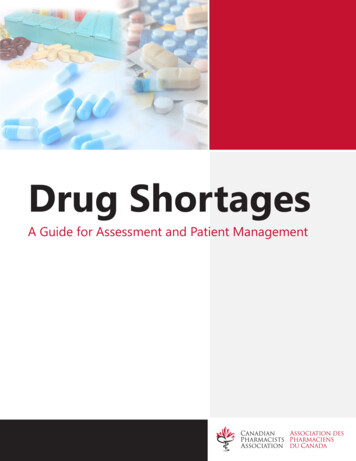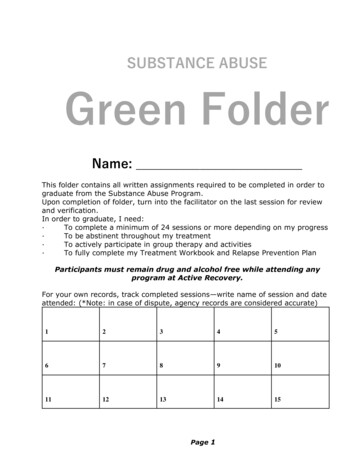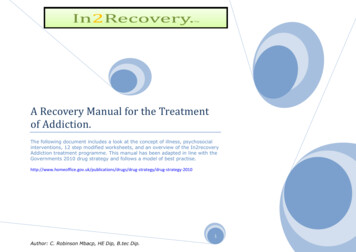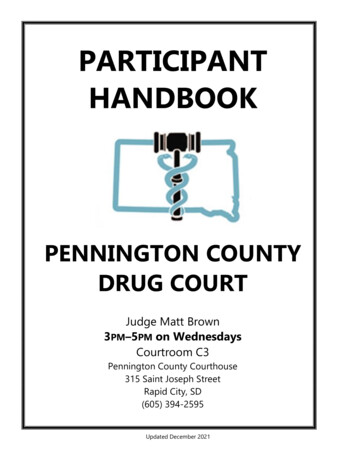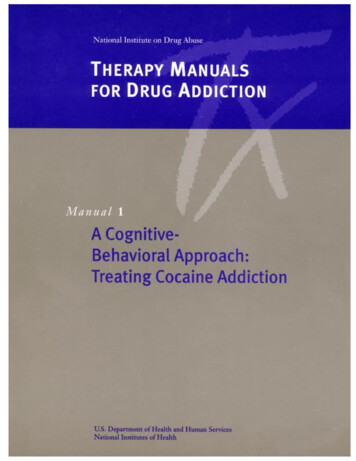
Transcription
i
ACKNOWLEDGMENTSThe development of earlier versions of this manual was supported by several research grants fromthe National Institute on Drug Abuse. The current manual was written by Dr. Kathleen Carroll ofYale University under Contract Number N-OIDA-4-2205 with the National Institute on Drug Abuse.Dr. Lisa Onken, the NIDA Project Officer, offered valuable guidance and comments throughout thepreparation of this manual.The material presented in this manual is the result of a program of research by Dr. Kathleen Carrolland Dr. Bruce Rounsaville and their colleagues at Yale University. The development of this therapymodel for treatment of drug abuse drew extensively from the work of Alan Marlatt and others(Marlatt and Gordon 1985; Chancy et al. 1978; Jaffe et al. 1988; Ito et al. 1984). The structure andsequence of sessions presented in this therapy model was partially developed by work on ProjectMATCH published by the National Institute on Alcohol Abuse and Alcoholism (Kadden et al. 1992)and the manual developed by Peter Monti and his colleagues (1989). These sources are particularlyreflected here in the a skills-training material, and we have acknowledged the original sources ineach of those sections.Yale University Research TeamCoinvestigators:Bruce Rounsaville, M.D.Charla Nich, M.S.Sam Ball, Ph.D.Lisa Fenton, Psy.D.Frank Gawin, M.D.Tom Kosten, M.D.Elinor McCance-Katz, M.D., Ph.D.Douglas Ziedonis, M.D.Project staff:Meghan Brio, M.S.Roseann Bisighini, M.S.Monica Canning-BallJoanne Corvino, M.P.H.Kea CoxLynn Gordon, R.N.Tami Frankforterjenniffer OwlerTherapists:Michael Barrios, Ph.D.Dan Keller, Ph.D.Andrew Grunebaum, Ph.D.DisclaimerThe opinions expressed herein are the views of the author and do not necessarily reflect the officialpolicy or position of the National Institute on Drug Abuse or any other part of the U.S. Departmentof Health and Human Services.Public Domain NoticeAll material appearing in this report except the forms (Exhibit 9, Exhibit 13 and Exhibit 14) is in thepublic domain and may be reproduced without permission from the National Institute on Drug Abuseor the author. Citation of the source is appreciated.National Institute on Drug AbuseNIH Publication Number 98-4308Printed April 1998ii
ForewordMore than 20 years of research has shown that addiction is clearly treatable. Addiction treatment has been effective in reducing drug use and HIVinfection, diminishing the health and social costs that result from addiction, and decreasing criminal behavior. The National Institute on DrugAbuse (NIDA), which supports more than 85 percent of the world’sresearch on drug abuse and addiction, has found that the most effectivetreatment approaches include both biological and behavioral components.To ensure that treatment providers apply the most current science-basedapproaches to their patients, NIDA has supported the development of the“Therapy Manuals for Drug Addiction” series. This series reflects NIDA’scommitment to rapidly applying basic findings in real-life settings. Themanuals are derived from those used efficaciously in NIDA-supporteddrug abuse treatment studies. They are intended for use by drug abusetreatment practitioners, mental health professionals, and all others concerned with the treatment of drug addiction.The manuals present clear, helpful information to aid drug treatmentpractitioners in providing the best possible care that science has to offer.They describe scientifically supported therapies for addiction and givespecific guidance on session content and how to implement these techniques. Of course, there is no substitute for training and supervision, andthese manuals may not be applicable to all types of patients nor compatible with all clinical programs or treatment approaches. These manualsshould be viewed as a supplement to, but not a replacement for, carefulassessment of each patient, appropriate case formulation, ongoing monitoring of clinical status, and clinical judgment.The therapies presented in this series exemplify the best of what wecurrently know about treating drug addiction. As our knowledge evolves,new and improved therapies are certain to emerge. We look forward tocontinuously bringing you the latest scientific findings through manualsand other science-based publications. We welcome your feedback aboutthe usefulness of this manual series and any ideas you have on how itmight be improved.Alan I. LeshnerDirectorNational Institute on Drug Abuseiii
BLANK PAGEiv
ContentsForeword .iiiCognitive-Behavioral Therapy: An Overview .1Why CBT? .1Components of CBT .2Functional Analysis .2Skills Training .2Critical Tasks .3Parameters of CBT .4Format .4Length .4Setting .5Patients .5Compatibility With Adjunctive Treatments .6Active Ingredients of CBT .6Essential and Unique Interventions .7Recommended But Not Unique Interventions .7Acceptable Interventions .8Interventions Not Part of CBT .8CBT Compared to Other Treatments .8Similar Approaches .8Cognitive Therapy .9Community Reinforcement Approach .9Motivational Enhancement Therapy .9Dissimilar Approaches .10Twelve-Step Facilitation .10Interpersonal Psychotherapy .11Basic Principles of CBT .13Learned Behavior .13Modeling .13Operant Conditioning .13Classical Conditioning .14v
Functional Analysis .14Deficiencies and Obstacles .14Skills and Strengths .14Determinants of Cocaine Use .15Relevant Domains .15Assessment Tools .16Skills Training .17Learning Strategies Aimed at Cessation of Cocaine Use .18Generalizable Skills .19Basic Skills First .19Match Material to Patient Needs .19Use Repetition .20Practice Mastering Skills .22Give a Clear Rationale .22Get a Commitment .22Anticipate Obstacles .23Monitor Closely .23Use the Data .24Explore Resistance . 24Praise Approximations .24The Structure and Format of Sessions .2520/20/20 Rule . 25First Third of Session .26Assess Patient Status .26Urine Tests .26Problem Solving .28Listen for Current Concerns .28Discuss the Practice Exercise .29Second Third of Session .29Introduce the Topic .29Relate Topic to Current Concerns .30Explore Reactions .30Final Third of Session .31Assign a Practice Exercise .31Anticipate High-Risk Situations .32Topics .32Integrating CBT and Medication .35Session 1: Introduction to Treatment and CBT .39Session Goals .39Key Interventions .39History and Relationship Building .39vi
Enhance Motivation .41Negotiate Treatment Goals .42Present the CBT Model .43Establish Treatment Ground Rules .45Introduce Functional Analysis .45Practice Exercise .45Topic 1: Coping With Craving .47Session Goals .47Key Interventions .47Understanding Craving .47Describing Craving .48Identifying Triggers .49Avoiding Cues .49Coping With Craving .50Distraction .50Talking About Craving .50Going With the Craving .51Recalling Negative Consequences .51Using Self-Talk .52Practice Exercise .52Topic 2: Shoring Up Motivation and Commitment to Stop .55Session Goals .55Key Interventions .56Clarify Goals .56Address Ambivalence About Abstinence .58Identifying and Coping With Thoughts About Cocaine .59Recognize .59Avoid .59Cope .60Practice Exercises .61Topic 3: Refusal Skills/Assertiveness .65Session Goals .65Key Interventions .66Assess Cocaine Availability .66Handling Suppliers .66Cocaine Refusal Skills .67Within-Session Role-Play .67Passive, Aggressive, and Assertive Responding .68Remind Patients of Termination .68Practice Exercises .69vii
Topic 4: Seemingly Irrelevant Decisions .72Session Goals .72Key Interventions .73Understand Seemingly Irrelevant Decisions .73Identify Personal Examples .74Practice Safe Decision-making .74Practice Exercise .75Topic 5: An All-Purpose Coping Plan .77Session Goals .77Key Interventions .77Anticipate High-Risk Situations .77Develop a Coping Plan .78Practice Exercise .78Topic 6: Problemsolving .80Session Goals .80Key Interventions .80Introduce the Basic Steps .82Practice Problem-solving Skills .82Practice Exercise .82Topic 7: Case Management .84Session Goals .84Key Interventions .85Problem Identification .85Goal Setting .85Resource Identification .85Specifying a Plan .85Monitoring Progress .85Practice Exercise .86Topic 8: HIV Risk Reduction .88Session Goals .88Key Interventions .88Assess Risk .88Build Motivation to Change .89Set Goals .89Problem-solve Barriers .89Provide Specific Guidelines .90viii
Practice Exercise .90Significant Other Session .92Session Goals .92Key Interventions .92Plan Ahead .92Provide Information/Set Goals .93Identify Strategies .93Practice Exercise .94Final Session: Termination .95Session Goals .95Appendix A: Therapist Selection, Training, and Supervision . 97Therapist Training .97Didactic Seminar .97Supervised Training Cases .97Rating of Therapists .98Therapist Checklist .98Rating Scale .99Certification of Therapists .99Ongoing Supervision .99Guidelines .100Common Problems Encountered in Supervision .100Balance .100Speeding Through Material .101Overwhelming the Patient .101Unclear Strategies .101No Specific Examples .102Downplaying Practice Exercises .102Abandoning the Manual With Difficult Patients .102Appendix B: Clinical Research Supporting CBT .115CBT and Interpersonal Therapy .116CBT and Clinical Management .116CBT and Depressive Symptoms .118CBT and Alexithymia .119One-Year Follow-up .119CBT and Alcoholic Cocaine Abusers .120References .123ix
Cognitve-Behavioral Therapy: An OverviewCognitive-behavioral coping skills treatment (CBT) is a short-term, focusedapproach to helping cocaine-dependent individuals (In this manual, the termcocaine abuser or cocaine-dependent individual is used to refer to individuals who meet DSM-IV criteria for cocaine abuse or dependence.) becomeabstinent from cocaine and other substances. The underlying assumption isthat learning processes play an important role in the development and continuation of cocaine abuse and dependence. These same learning processescan be used to help individuals reduce their drug use.Very simply put, CBT attempts to help patients recognize, avoid, and cope.That is, RECOGNIZE the situations in which they are most likely to usecocaine, AVOID these situations when appropriate, and COPE more effectively with a range of problems and problematic behaviors associated withsubstance abuse.Why CBT?Several important features of CBT make it particularly promising as a treatment for cocaine abuse and dependence: CBT is a short-term, comparatively brief approach well suited to theresource capabilities of most clinical programs.CBT has been extensively evaluated in rigorous clinical trials andhas solid empirical support as treatment for cocaine abuse. In particular, evidence points to the durability of CBT’s effects as well asits effectiveness with subgroups of more severely dependent cocaineabusers (see appendix B).CBT is structured, goal-oriented, and focused on the immediate problems faced by cocaine abusers entering treatment who are strugglingto control their cocaine use.CBT is a flexible, individualized approach that can be adapted to awide range of patients as well as a variety of settings (inpatient, outpatient) and formats (group, individual).1
CBT is compatible with a range of other treatments the patient mayreceive, such as pharmacotherapy. CBT’s broad approach encompasses several important common tasks of successful substance abuse treatment.Components of CBTCBT has two critical components:Functional AnalysisSkills Training2 Functional analysis Skills trainingFor each instance of cocaine use during treatment, the therapist and patientdo a functional analysis, that is, they identify the patient’s thoughts, feelings,and circumstances before and after the cocaine use. Early in treatment, thefunctional analysis plays a critical role in helping the patient and therapistassess the determinants, or high-risk situations, that are likely to lead to cocaine use and provides insights into some of the reasons the individual maybe using cocaine (e.g., to cope with interpersonal difficulties, to experiencerisk or euphoria not otherwise available in the patient’s life). Later in treatment, functional analyses of episodes of cocaine use may identify those situations or states in which the individual still has difficulty coping.CBT can be thought of as a highly individualized training program that helpscocaine abusers unlearn old habits associated with cocaine abuse and learn orrelearn healthier skills and habits. By the time the level of substance use issevere enough to warrant treatment, patients are likely to be using cocaine astheir single means of coping with a wide range of interpersonal andintrapersonal problems. This may occur for several reasons: The individual may have never learned effective strategies to copewith the challenges and problems of adult life, as when substance usebegins during early adolescence. Although the individual may have acquired effective strategies at onetime, these skills may have decayed through repeated reliance on substance use as a primary means of coping. These patients have essentially forgotten effective strategies because of chronic involvement ina drug-using lifestyle in which the bulk of their time is spent in acquiring, using, and then recovering from the effects of drugs. The individual’s ability to use effective coping strategies may be
weakened by other problems, such as cocaine abuse with concurrent psychiatric disorders.Because cocaine abusers are a heterogeneous group and typically come totreatment with a wide range of problems, skills training in CBT is made asbroad as possible. The first few sessions focus on skills related to initialcontrol of cocaine use (e.g., identification of high-risk situations, copingwith thoughts about cocaine use). Once these basic skills are mastered, trainingis broadened to include a range of other problems with which the individualmay have difficulty coping (e.g., social isolation, unemployment). In addition, to strengthen and broaden the individual’s range of coping styles, skillstraining focuses on both intrapersonal (e.g., coping with craving) and interpersonal (e.g., refusing offers of cocaine) skills. Patients are taught theseskills as both specific strategies (applicable in the here and now to controlcocaine use) and general strategies that can be applied to a variety of otherproblems. Thus, CBT is not only geared to helping each patient reduce andeliminate substance use while in treatment, but also to imparting skills thatcan benefit
drug abuse treatment studies. They are intended for use by drug abuse treatment practitioners, mental health professionals, and all others con-cerned with the treatment of drug addiction. The manuals present clear, helpful information to aid drug treatment practitioners in pr
